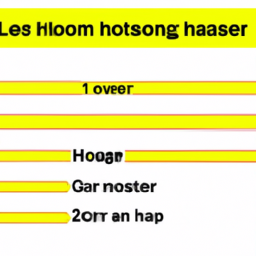Garden Hose Flow Rate How Many Gallons Per Hour
How Many Gallons Per Hour Is A Garden Hose
Introduction
For anyone planning to undertake gardening projects, it's essential to know the flow rate or how many gallons per hour (GPH) an individual garden hose can deliver. Since different types of garden hoses provide different GPH, understanding the concept and how to measure GPH is critical to ensure a successful gardening venture. To help answer the age-old questions of How many gallons per hour is a garden hose? we'll provide an overview of the different kinds of garden hoses, why it matters, and how to calculate GPH.
What to consider when selecting a garden hose
Before we get into how to calculate GPH, it's important to understand what to consider when selecting the garden hose. In this section, we'll review the differences between conventional hoses versus hoses equipped with a nozzle, and the three categories of garden hoses, which include lightweight hoses, standard garden hoses, and heavy-duty garden hoses.
Conventional Vs. Nozzle Hoses
Conventional hoses come with an attached hose coupling that is used to screw onto the water spigot, without providing any additional benefits. A nozzle hose, on the other hand, allows the user to shut off the flow of water, and adjust the strength of the water blast coming out of the end.
Types of Garden Hoses
When shopping for garden hoses, the consumer can choose between lightweight hoses, standard garden hoses, and heavy-duty hoses. Lightweight hoses are more flexible, making them easier to maneuver, but offer less GPH. Standard garden hoses are the most common type of hose and are suitable for most gardening tasks. As for heavy-duty hoses, they are more pleasant to use, last longer, and can provide greater GPH.
Why GPH Matters
The GPH of the garden hose can determine how long it takes to fill up a pool, a bucket, a fountain, or even an irrigation system. For those looking to use a garden hose as an irrigation system, for instance, it would be more efficient to use a garden hose with a larger GPH. Generally speaking, a garden hose with a larger GPH can save time, money, and energy.
How to Calculate GPH
To determine the exact GPH, one must measure the amount of time it takes to fill up a container with a known volume, and doing so requires a few components and a bit of patience. You'll need a timer, a known volume container, and the garden hose, of course. First, time how long it takes to fill up the container with the hose completely and then calculate the amount of water collected. Divide the number of gallons of water collected by the amount of time to get the GPH.
In Summary
Whether you're filling a pool, a water bucket, or an irrigation system, it's important to understand the different types of garden hoses available, as well as the various GPH capabilities. To select the right kind of hose, it's a good idea to weigh the pros and cons of conventional hoses versus nozzles, and to consider the various options when it comes to lightweight, standard, and heavy-duty hoses. Finally, in order to obtain an exact measure of GPH for any given hose, it's important to time and measure the amount of water collected. Knowing these elements will help to ensure any gardening venture is successful and efficient.

Previous Page
Next Page
